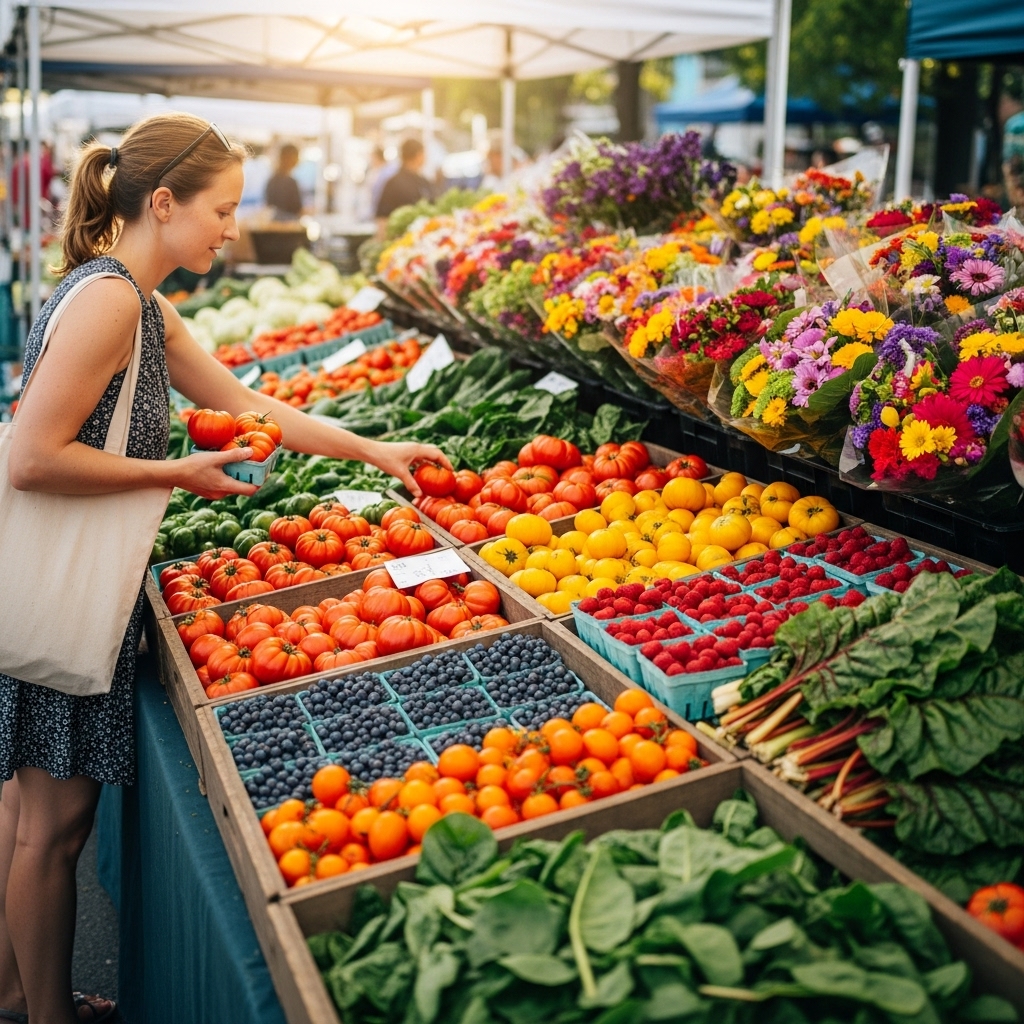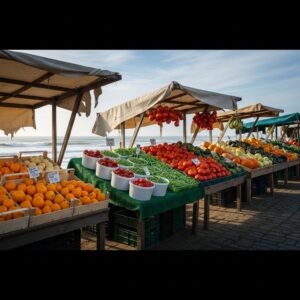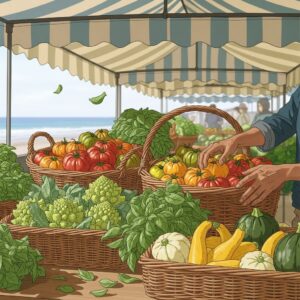Welcome to Your Comprehensive Naperville Fresh Market Guide
Stepping into the vibrant fresh market scene in Naperville, Illinois is like opening the door to a weekly community festival filled with color, aroma, and friendly conversations. Whether you are a longtime resident or a new neighbor, this guide will help you make the most of every shopping trip, from understanding seasonal produce to navigating vendor stalls like a pro. To begin, set yourself up for savings and inspiration by checking the latest weekly deals, then plan your route through the market with your pantry needs in mind. With a little preparation and the right expectations, you can turn weekend shopping into an easy, enjoyable ritual that fuels healthy meals and local connections.
At the heart of Naperville’s fresh market culture are farmers, bakers, artisans, and specialty producers who take real pride in their craft. Markets often showcase locally grown fruits and vegetables, small-batch dairy and eggs, pasture-raised meats, heirloom grains, fair-trade coffee roasters, handmade pastas, and inventive condiments. You will also find flowers, herb starts, and sometimes prepared foods that are ready to enjoy while you stroll. The atmosphere is welcoming and relaxed, encouraging questions, taste-testing, and conversations with growers about their fields, harvest cycles, and favorite cooking methods. This guide will unpack how to pick produce with confidence, plan meals around what is in season, and build relationships that make your shopping more personal and rewarding.
Understanding the Rhythm of the Market
Markets in Naperville follow the agricultural calendar, which means what you see on tables changes week by week. In late spring and early summer, expect tender greens, radishes, asparagus, rhubarb, and strawberries. As summer warms, tomatoes, cucumbers, peppers, sweet corn, zucchini, green beans, melons, and blueberries arrive in abundance. By late summer and into fall, varieties of squash, apples, pears, broccoli, Brussels sprouts, and root vegetables take center stage. This rhythm is a gift: it inspires variety in your meals and helps you discover flavors at their peak. Keep a notepad or phone list of recipes you want to try as certain ingredients return to season, then shop with those dishes in mind.
Another benefit of seasonal shopping is freshness. Shorter travel times mean produce spends less time in transit and more time on the plant, which often translates to better flavor and texture. Talk to vendors about when items were harvested; many pick the day before the market or even that morning. For delicate items like berries or salad greens, this timing can make a noticeable difference in taste and shelf life. If you are cooking for a crowd or looking to prep meals for the week, ask growers which varieties hold up best once you get them home.
How to Navigate Like a Local
Before you buy, walk the entire market to compare quality, variety, and any special offers. This quick survey helps you decide where your budget and appetite will be best spent. If a particular stall is unusually crowded, it might indicate a beloved specialty or a limited batch worth sampling. Bring a roomy tote or rolling cart, which keeps your hands free and prevents delicate items from being crushed. A small cooler pack is helpful if you plan to buy eggs, cheese, or meat, especially on warmer days when you want to linger and chat.
Timing makes a difference. Early shoppers get first pick, which is ideal if you need a specific item or want pristine selections for entertaining. Late arrivals sometimes encounter reduced inventory but may benefit from flexible bundles as vendors prepare to pack up. If you are new to a stall, let the vendor know how you plan to use an ingredient. They can recommend the best ripeness for grilling, slow-cooking, or raw preparations, and they may steer you toward varieties you have not tried. These personalized tips are part of the value that markets deliver and are rarely available in typical retail settings.
Building Flavor with Seasonal Strategy
Meal planning around seasonal produce can transform weeknight cooking. Start with a base of versatile items that serve multiple dishes—think tomatoes, leafy greens, onions, carrots, and herbs—then add one or two “hero” ingredients that spark creativity. For instance, if you find fragrant peaches, plan to grill them alongside chicken or toss them into a salad with arugula and goat cheese. If you discover a vendor with a unique chili variety, ask how they use it at home and jot down ideas for salsas or marinades. The market is not just where you buy food; it is a source of culinary education directly from the people who know the ingredients best.
Consider how to extend your haul throughout the week. Many vegetables can be prepped on market day: wash and spin dry greens, roast a tray of mixed vegetables, or blanch and freeze extra sweet corn. These simple steps save time when the week gets busy and help prevent waste. If you are interested in preserving, chat with growers about the best canning tomatoes or pickling cucumbers, and ask about upcoming weeks when larger quantities might be available.
Quality, Freshness, and Transparency
One of the greatest advantages of shopping the fresh market in Naperville is transparency. You can ask farmers how they control pests, whether they use synthetic sprays, and how they build soil health. Some vendors are certified organic, while others follow natural practices without formal certification. Understanding these nuances helps you align purchases with your values. Look for signs that detail farm locations, growing methods, and harvest schedules. If you have allergies or dietary preferences, this direct access to producers makes it easier to shop with confidence.
Carry a small notebook or create a digital note for vendors you love. Record what you tried and how you used it, then note stall locations and market days. Over time, you will build a personal map of trusted suppliers for staple items and seasonal treats. Many shoppers also create an informal rotation, visiting a few favorite farms each week and rotating in new stalls to explore variety. This balance ensures reliable quality while keeping your meals interesting.
Smart Budgeting Without Compromising Taste
Even without focusing on exact numbers, you can maximize value through smart choices. Opt for whole produce rather than pre-chopped versions when possible. Select versatile items that serve multiple roles across your weekly menu. Consider purchasing slightly imperfect fruits and vegetables for sauces, soups, and smoothies; vendors may mark them as seconds, and they often taste just as good. Planning meals around items that are abundant can help you stretch your dollars and reduce waste. If you are feeding a group, ask vendors about the best varieties for feeding a crowd, focusing on flavor, ease of preparation, and reliability.
Consider the value in specialty items that elevate simple meals. A small jar of a robust spice blend or a bright vinegar can transform roasted vegetables or simple salads. Fresh herbs are particularly cost-effective because they add complex flavor with very small amounts. Ask vendors for storage tips to extend herb freshness—many stems last longer in a jar of water in the refrigerator, loosely covered, which keeps them crisp for several days.
Community, Events, and Education
Naperville’s markets often feature live music, chef demos, and kid-friendly activities that make shopping an experience rather than a chore. Keep an eye out for themed weekends that spotlight certain crops or cooking methods. You may find tastings of heirloom tomatoes, tutorials on fermenting vegetables, or recipes that highlight midsummer zucchini. These events are fun, but they also expand your culinary skills. If you attend a demo, consider following the recipe right away while the techniques are fresh in your mind and the ingredients are at peak flavor.
Do not underestimate the social value of the market. It is a place to foster relationships with neighbors and farmers, ask candid questions, and share ideas. Over time, vendors get to know your preferences and may give you a heads-up when your favorite variety or crop is coming into season. These conversations turn shopping into a community ritual you will look forward to every week.
Mid-Trip Strategy and Finding Inspiration
At the midpoint of your visit, re-check your plan and recalibrate your list. If you discovered an unexpected ingredient—say, a new variety of kale or a just-picked melon—make room for it by swapping out something less exciting. This flexibility keeps your cooking adventurous. To spark ideas or confirm availability before your next trip, browse the latest weekly deals and note which ingredients appear frequently. Patterns of abundance suggest dishes that will be easy to execute repeatedly, like roasted root vegetable bowls in fall or chilled cucumber soups during heat waves.
If you cook for multiple eaters with different tastes, divide your haul into themed mini-menus. For example, assemble a Mediterranean set with tomatoes, cucumbers, olives from a specialty stand, and feta from a local creamery, then create a second set geared toward comfort food with potatoes, onions, and a hearty winter squash. This method streamlines weekday meals and makes it easier to accommodate varied preferences.
Storage, Safety, and Longevity
Handle your purchases carefully as you shop. Keep delicate greens on top, avoid squashing tomatoes with heavier items, and separate raw meats or eggs into a cooler compartment. At home, rinse greens and berries with cool water and dry them thoroughly before storing. Tomatoes prefer room temperature for best flavor, while most other vegetables benefit from cool, humid environments. If you are unsure, ask the vendor; they know exactly how the produce behaves post-harvest. Label containers so you remember what to use first and reduce the risk of forgetting delicate items in the crisper.
Batch cooking on market day helps protect your investment. Roasting, grilling, or quick-pickling excess produce provides ready-to-eat components for the week and extends shelf life. If you plan to freeze items, cool them quickly after cooking and store in airtight containers labeled with contents and date. With a little organization, nothing goes to waste and your weekday meals come together faster.
Simple Meal Ideas from a Single Market Haul
Turn greens, tomatoes, cucumbers, and herbs into a hearty salad topped with grilled fish or chicken. Toss pasta with sautéed zucchini, garlic, and a squeeze of lemon, then finish with a handful of basil. Build a sheet pan dinner with potatoes, onions, carrots, and sausages from a local vendor for an easy one-pan meal. For breakfast, layer yogurt with berries and a drizzle of local honey, or scramble eggs with wilted greens and roasted peppers. For dessert, try macerating peaches with a splash of citrus and spooning them over vanilla ice cream. These ideas rely on minimal ingredients and simple techniques, letting the freshness shine.
If you have children, make market shopping a mini adventure by letting them choose a new fruit or vegetable each week. Involving them in selection and preparation increases the chance they will enjoy new flavors. For older kids and teens, consider a scavenger hunt: find three leafy greens, identify two varieties of apples, or ask a farmer which vegetable they are most proud of this season. Turning the trip into a game keeps everyone engaged.
Frequently Asked Questions
Q: What time should I arrive for the best selection? A: Arriving shortly after opening typically offers the widest choice and the freshest picks. If you prefer a more relaxed pace, late morning works well, though some items may sell out.
Q: How do I know if produce is local? A: Ask vendors where their farm is located and how recently items were harvested. Many stalls display signs with farm names and growing practices.
Q: Can I bring my dog? A: Policies vary by market location and event. Check posted guidelines on-site; if pets are allowed, keep them leashed and mindful of other shoppers.
Q: What should I bring? A: A sturdy tote or cart, small cooler packs for perishables, and a list of meal ideas. Comfortable shoes and a water bottle help if you plan to linger.
Q: How do I keep greens fresh? A: Wash, spin, and store in a breathable container with a dry towel to absorb moisture. Most greens keep well for several days when handled gently.
Q: Are samples available? A: Many vendors offer tastings when feasible. Always ask politely and use the provided utensils or napkins to keep things sanitary.
Shop Confidently and Enjoy the Experience
You now have the tools to approach Naperville’s fresh market with a clear plan, flexible creativity, and genuine curiosity. Start with a quick walkthrough, talk to farmers, and let the ingredients guide your meals. Remember to protect delicate items, prep a few basics on market day, and organize your haul so nothing goes to waste. As you refine your routine, you will discover favorite stalls, new flavors, and reliable seasonal rhythms that make shopping a pleasure rather than a task.
If you are ready to plan your next trip and want inspiration for what to cook this week, explore the latest weekly deals, write a short ingredient wish list, and head out early with an open mind. Your table will reflect the best of Naperville’s farms and food artisans, and your meals will tell the story of a community that cares about flavor, sustainability, and neighborly connection.




